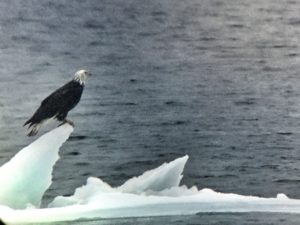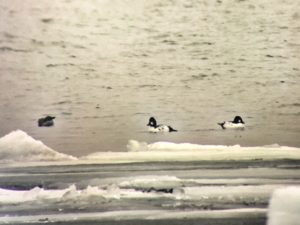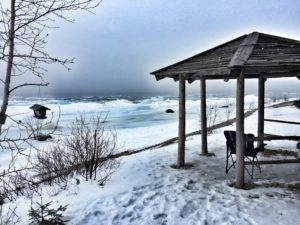
Weather-
Today started off above freezing at 2.3 C with light rain falling. Visibility was limited to 2 miles, the northern shoreline of the straits obscured by fog. Very low nimbostratus clouds came and went past McGulpin Point. The barometric pressure fell steadily over the 4 hours of todays count. It continued to rain off and on, but the visibility by the end of the count was limited to 100 meters off the point. No wind or wave action to speak of. By the end of the count the temperature had hardly changed.
The wall of ice to the west was rapidly diminishing in the rain. The shore ice too was shifting quickly and it probably won’t be long before it is gone and the wall of blue ice moves on. This will greatly help with detections to the west of the count location.

Waterbird Notes-
Despite the rain, waterbirds were moving through today. The birds that did move through were close to the point, however the fog certainly could have made detections more than 2 miles difficult. That 2 miles gradually decreased to 100 meters by noon. At that point I could hear Common Goldeneye whistling by, but I was unable to spot them in the fog. Since the fog slowly moved in over a 4 hour period I wasn’t completely aware of how this was impacting detections as it is difficult to determine the edge of the fog over open water as it approaches. Even at 2 miles birds would suddenly appear out of the fog from nowhere. It was interesting to observe how this caused all species of waterfowl to hug the shore and fly low. The rain and fog did seem to put a damper on courtship displays by Common and Red- breasted Merganser as well as Common Goldeneye. A few small groups gathered and attempted to display only to disband quickly. The highlight of the morning was 3 Long- tailed Duck who flew in fairly close to shore from west to east, landing somewhere to the east of the point out of view. These birds have striking plumage and I enjoy seeing waterbirds I haven’t seen since working in the Arctic National Wildlife Refuge. It is special to have seen them on nests in their breeding range and now en-route to the arctic during migration. I could always tell if an arctic fox was sniffing around in the never ending light of the arctic summer when I heard a Long- tailed Duck calling amongst the other birds sounding off their alarms.
Non-waterbird Notes-
The resident adult Bald Eagle was perched on the ice less than 100 meters from the gazebo. The eagles presence appeared to have an impact on waterbirds loafing, foraging or courting in the area. A bold Herring Gull made quite a fuss about this and eventually the eagle left of its own accord.
Visitors-
None except for the feeder birds. It will probably only be a few more days if the weather stays warm before the treacherous descent to the lakeshore is melted out. It was almost mushy today, but if it freezes again I have no doubt it will be slick. I am looking forward to it melting out as I will be able to drive down to the count location which will cut down on the time needed for my commute. Also, the eBird output will be down for the next few days until the system we log data into gets dialed in. However, check out tomorrows post as there is another way you may follow waterbird migration in real time!

Total observer hours – 4.25
Next Day Forecast-
Patchy fog before 11:00AM. Otherwise, mostly sunny, with a high near 40F.
Long- tailed Duck – 3
Bufflehead – 1
Common Goldeneye- 20
Common Merganser – 15
Red- breasted Merganser – 33
merganser sp. – 5
duck sp. – 5
Ring- billed Gull – 2
Herring Gull – 2
Bald Eagle – 1 Adult
Mourning Dove – 1
American Crow – 2
Black- capped Chickadee – 5
Golden- crowned Kinglet – 1
American Robin – 1
Common Redpoll – 3
Pine Siskin – 2
